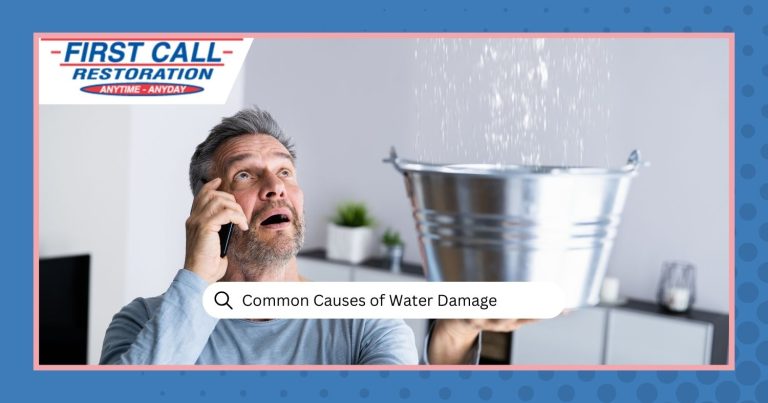Table of Contents
ToggleFirst Call Restoration specializes in mold removal. Our owner, Mike Hogan, is passionate about educating consumers about mold!
Awareness is our goal and this is the reason we offer consumers in the Southeast New York area so many informative articles on mold.
The purpose of this article is to explore the health aspects of mold, by answering two key questions that we are often asked:
- How do I know if mold is making me sick?
- If I am diagnosed with mold sickness, what can I do?
Experts at mold remediation in your home or office
Contact us today
(845) 442-6714
How Do I Know Mold Is Making Me Sick?

Since launching the website, several mold sensitized individuals have been interviewed. Many lessons can be learned from these interviews.
- In general, there is a lack of appreciation amongst the medical community of the impact that mold can have on certain individuals.
- The symptoms from mold sickness are broad, leading to multiple mis-diagnosis of patients by many doctors.
- It is quite common for mold sensitized individuals to seek help from multiple medical practitioners and still not get healthy.
- Eventually, the individual learns that mold has been the cause of the sickness.
- Mold sensitized individuals frequently are forced to seek alternative shelters because traditional remediation approaches are not adequate to address their sensitivities, even assuming that the current standard of care is followed.
According to the MOLDY documentary, 28 percent of the population have genes that make them highly susceptible to mold-related health issues.
What Is Chronic Inflammatory Response Syndrome?

According to Dr. Richie Shoemaker, a physician and expert in the field of biotoxin-related illness and author of the book Surviving Mold, the most common condition associated with mold illness is Chronic Inflammatory Response Syndrome.
Chronic Inflammatory Response Syndrome (CIRS), also known as Sick Building Syndrome (SBS), is a combination of illnesses or aliments that are in direct relation with an individual’s place of work or home environment:
An acute and chronic, systemic inflammatory response syndrome acquired following exposure to the interior environment of a water-damaged building with resident toxigenic organisms, including, but not limited to fungi, bacteria, actinomycetes and mycobacteria as well as inflammagens such as endotoxins, beta glucans, hemolysins, proteinases, mannans, c-type lectins and possibly spirocyclic drimanes, plus volatile ogranic compounds.
The term Sick Building Syndrome was first coined by the World Health Organization in the 1980s and it is believed that it is caused by poor air quality caused by water damage.
According to Shoemaker:
This illness happens after exposure to the interior environment of a Water-Damaged Building (WDB). There are many ways buildings become home to a toxic mix of microbes, fragments of microbes, and harmful chemicals. Buildings can host fungi, bacteria, mycobacteria, and actinomycetes as a result of construction defects like inappropriate ventilation; faulty construction of crawl spaces or inadequate building design; flat roofs or fake stucco cladding without adequate caulking; incomplete basements exposed to saturated ground water conditions; or not correcting water leaks.
According to Shoemaker, 25% of the population has a genetic pre-disposition to CIRS; women tend to report more symptoms than men:
Genes made them prime targets for an assault by their own innate immune systems….exposure to the interior environment of a Water-Damaged Building (WDB), [causes] an innate immune response that is going haywire.
Individuals exposed to the toxins in a water damaged building suffer from chronic illness because their bodies are trying to eliminate the foreign substances that stay in the body resulting in chronic inflammation and multiple symptoms. In fact, one of the reasons that it is so difficult to diagnose CIRS is due to the fact that there are 37 symptoms: fatigue; weakness; aches; muscle cramps; unusual pain; ice pick pain; headache; light sensitivity; red eyes; blurred vision; tearing; sinus problems; cough; shortness of breath; abdominal pain; diarrhea; joint pain; morning stiffness; memory issues; focus/concentration issues; word recollection issues; decreased learning of new knowledge; confusion; disorientation; skin sensitivity; mood swings; appetite swings; sweats (especially night sweats); temperature regulation or dysregulation problems; excessive thirst; increased urination; static shocks; numbness; tingling; vertigo; metallic taste; and tremors.
Because of the large number of symptoms and different combinations that a patient can have, CIRS is difficult to diagnose.
If you have been suffering from ill-health for an extended period of time and the treatments that you are prescribed do not seem to help, then here are some recommended action steps.
- Listen to your body. If you are feeling sick and despite under-going multiple treatments still continue to feel sick, then do not give up on trying to find out what the cause is.
- Research mold sickness. The website, www.moldsensitized.com, has a significant amount of information on mold and it’s impact on health and is constantly updated with new information on its blog. These articles are informative:
Medical Evidence that Connects Mold Exposure to Illness Keeps Piling Up
Do People Really Get Sick From a Little Mold in Their House?
What is Stachybotrys Mold?
The Mystery of Mycotoxins in Mold Contamination
The WHO on Mold
TOP 10 Questions and Answers About Water-Damaged Buildings - Review the experiences of mold survivors to gain greater insight into mold sickness. One of the primary reasons you want to do this is so that you will have some further evidence that you can take to your preferred medical practitioner.
- Continue to educate yourself. Because of the lack of knowledge in the mainstream medical community, you need to take a lead role in determining whether mold is making you sick.
- Finally, if after all your research, you think that mold is the problem, then call First Call Restoration so we can inspect your home.
What Should I Do If I Am Diagnosed With Mold Sickness?

If you suspect that you are sick because of mold, then the next step is to find a Doctor that has knowledge about mold sickness. To find listings of environmental doctors throughout the world, click here.
Two Steps To Recovery!
Once you are diagnosed, there are two distinct steps to your recovery.
Seek Medical Treatment
Medical treatment is designed to detox your body and allow your immune system to recover and begin to regain its strength. The detox strategy will be prescribed by your physician who will likely recommend that you remove yourself from the property that has been making you sick until it is safe to occupy again.
Remediate Your Home
The process of removing mold from your home and ensuring that you can move back in without experiencing further sickness is the long term solution to health recovery.
Got Mold Questions?

First Call Restoration is here to help and committed to serving mold sensitized individuals. If you suspect that mold is making you sick, call us, (845) 442-6714 or contact us via e-mail for further assistance. Our goal is to help you live a healthier and happy life. Most importantly, we truly empathize with your situation and are committed to helping you. We look forward to serving you! 🙂
Experts at mold remediation in your home or office
Contact us today
(845) 442-6714
We do mold remediation.




